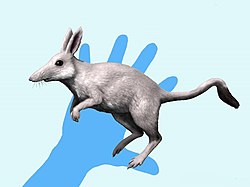| Sinodelphys Temporal range: Early Cretaceous, | |
|---|---|
 | |
| A reproduction of the holotype displayed at the French National Museum of Natural History, Paris | |
| Scientific classification | |
| Kingdom: | Animalia |
| Phylum: | Chordata |
| Class: | Mammalia |
| Clade: | Eutheria |
| Genus: | † Sinodelphys Luo et al., 2003 |
| Type species | |
| †Sinodelphys szalayi Luo et al., 2003 | |
Sinodelphys is an extinct mammal from the Early Cretaceous, estimated to be 125 million years old. It was discovered and described in 2003 in rocks of the Yixian Formation in Liaoning Province, China, by a team of scientists including Zhe-Xi Luo and John Wible. [1] While initially suggested to be the oldest known metatherian, later studies interpreted it as a eutherian.






